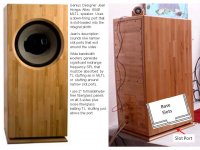Do you have a favorite driver that you would like to use in a mass loaded transmission line (MLTL) like a TABAQ, Pensil, or Metronome, but no one has yet run a simulation for it with MJK's software? Sometimes, folks on this forum can be very generous with their time and provide you a simulation if you ask. I have seen Bjohanessen do this many times for me and others. But in case you do not have the fortune of a full-blown simulation in MJK, but would like to hear what your driver sounds like in a MLTL, this thread is for you.
Let me first say that, this is not meant to replace a real simulation, but is rather an observation I have noticed that has worked a few times. I imagine that there are drivers where this will fail. For MLTL's where you want to push the tuning frequency below the natural free space frequency of the driver, choose a driver with a moderately high Qts (> 0.5).
This idea arose out of something I noticed happening on several occasions with a good result. I call it the 'accidental MLTL' technique because it may have been luck or chance but it seems to work a few times now for me (and at least once by others). I originally posted this in Bjohanessens's TABAQ thread but figured it was enough to spin off a new thread. I will repeat that post here...
If you happen to have MJK's MLTL worksheet, give this a try by running a simulation with your driver and running WinISD and calculating the CSA, length, and vent and compare the two. It would be interesting to hear your results.
----
Use WinISD bass reflex software (free) and plug in your driver's T/S params and design a vented bass reflex speaker enclosure using the default optimal case. That will give you the volume of the box and the vent cross sectional area and length.
Now choose a maximum length you are willing to have based on practical size constraints, typically 30 inches to 40 inches long. This will correspond to a quarter wave length that is probably higher than the tuning freq of the bass reflex design that came out of WinISD (circa 60 to 75 Hz).
Calculate the cross sectional area (csa) of the transmission line using volume from WinISD and the length you set. If the csa is bigger than you prefer, you can go off the optimal case by going back to WinISD and adjusting the box volume manually to a smaller value and tweaking the frequency even. You can play with the vent to get it to a diam and length you like. Typically, I do this because the default vent is not very practical. Then use new box volume and vent dimensions to calculate the new csa based in length of the line again.
Now build the enclosure with the csa and length and put a vent with dimensions from WinISD at the distal end. On the closed end, measure 1/3 of distance down and make cutout for driver and mount it there. Put polyfill stuffing from closed end to about half to 2/3 of the way down the line. Adjust this to taste, less stuffing gets more boomy bass. More stuffing gets tighter bass at expense of amplitude. I have found that the position of the driver need not be exactly at 2/3 and indeed can even be at the closed end.
Doing this approach will guarantee that at worst, the speaker will perform as a bass reflex optimized for volume and vent size. But if physics of a MLTL and quarter wave theory kick in, you will end up with a speaker that has deeper bass extension than predicted by WinISD. The speakers that I have built following this recipe have measured very well when I look at what is coming from the bass port - typically, I get the low frequency extended or 'pulled down' by an additional 15 Hz from the plain bass reflex prediction. The speakers also sound great - very balanced when the bass port output integrates with the direct radiation from the driver.
If you want to experiment without investing too much in wood, use foam core to build quick and dirty speaker. Even cardboard can be used as a test speaker for this.
----
Here are the two examples that have worked for me:
http://www.diyaudio.com/forums/full-range/223313-foam-core-board-speaker-enclosures-148.html
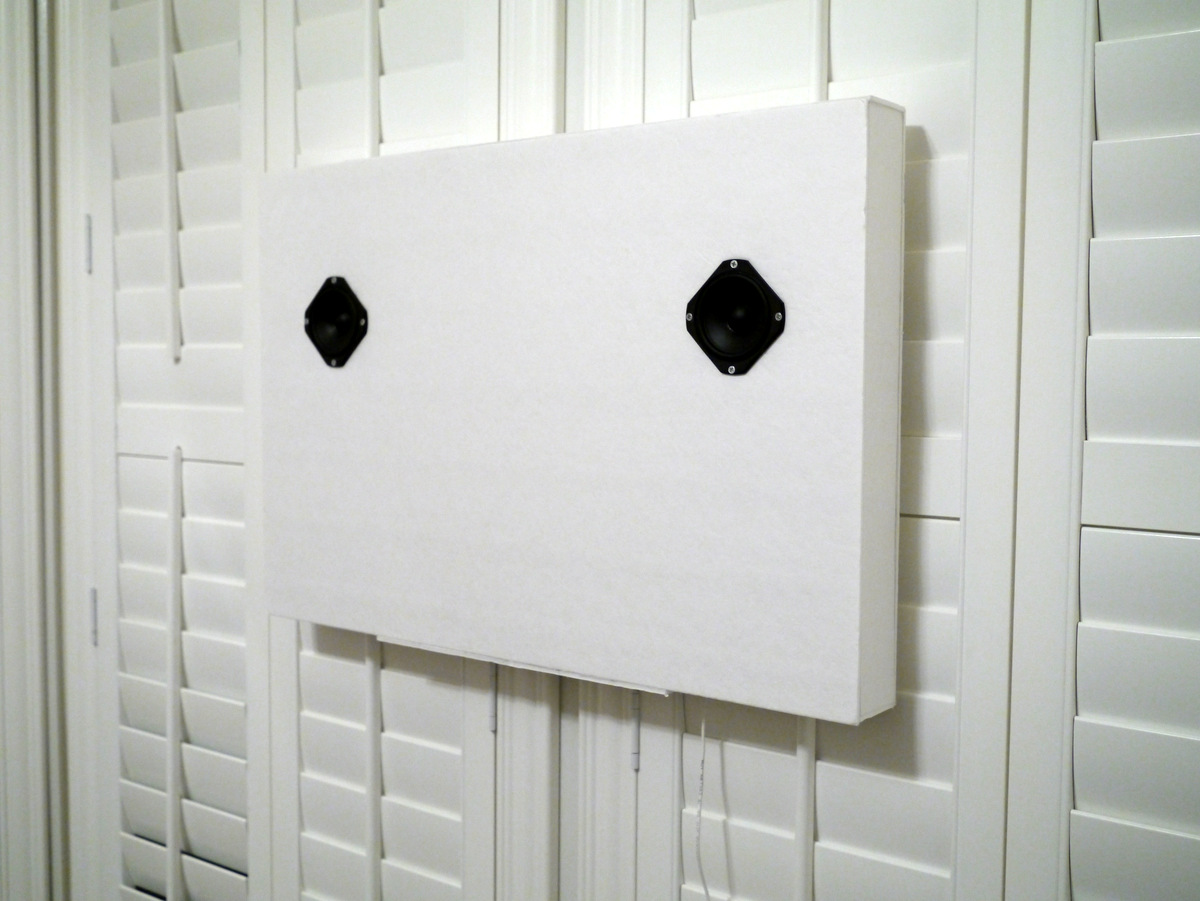
http://www.diyaudio.com/forums/full-range/223313-foam-core-board-speaker-enclosures-109.html
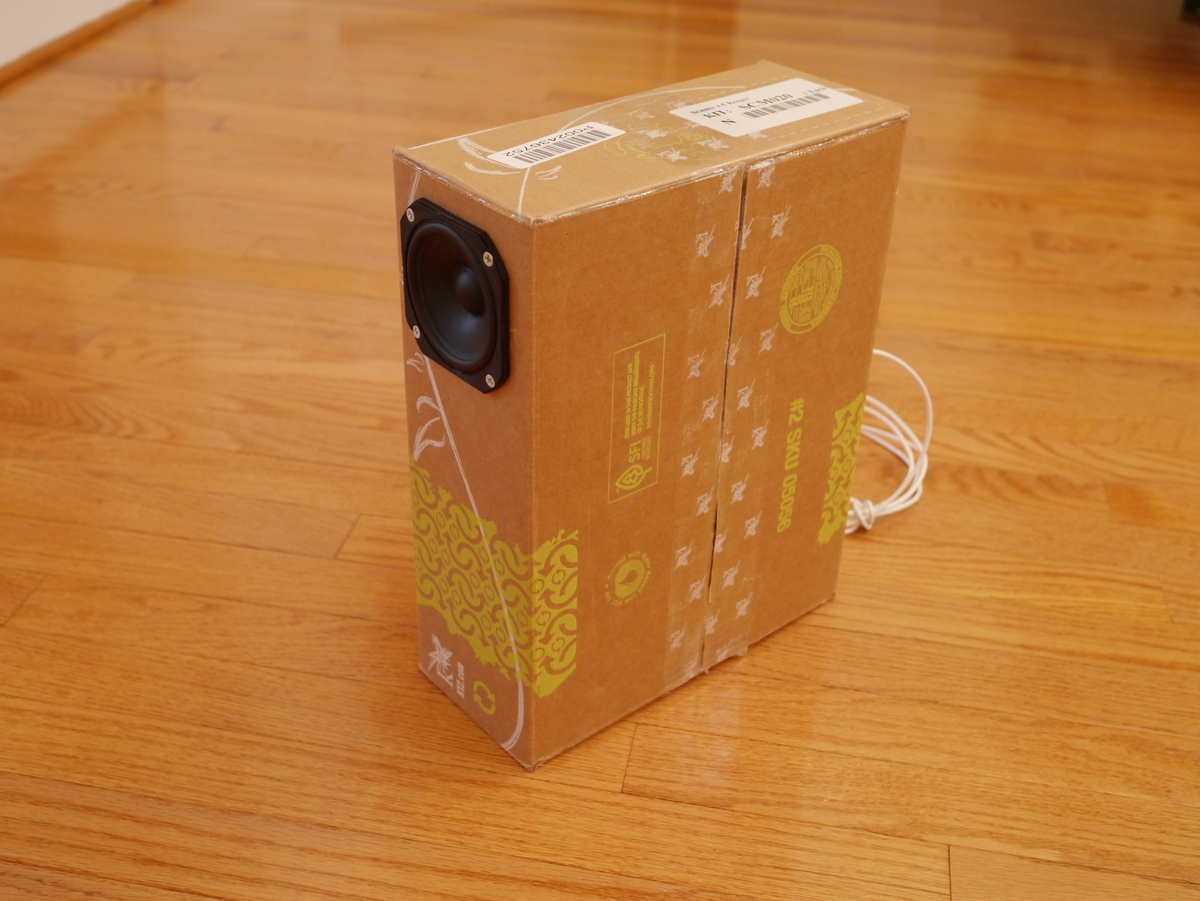
A third example not by me might be Cogitech's "nano tower" speaker with the ubiquitous TB W3-881si. Which I think was also designed as a bass reflex with WinISD but due to its slender aspect ratio and length, happens to have some very nice bass deeper than one would expect based on accounts from builders.
http://www.diyaudio.com/forums/full-range/200912-nanotower-tang-band-w3-881si.html
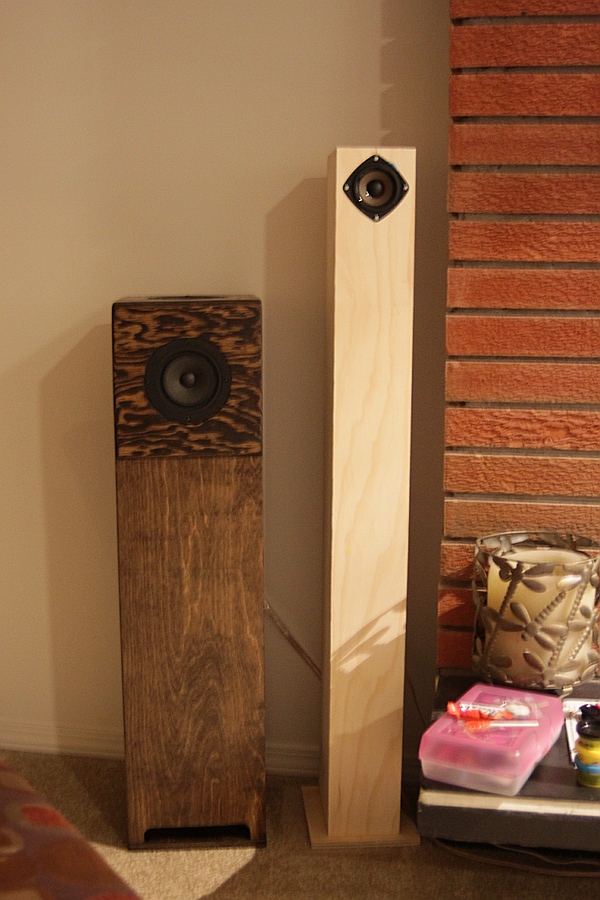
Update : 4th example is a quad driver bipole with W3-881si http://www.diyaudio.com/forums/full-range/234535-tangband-w3-881-mltl-build.html
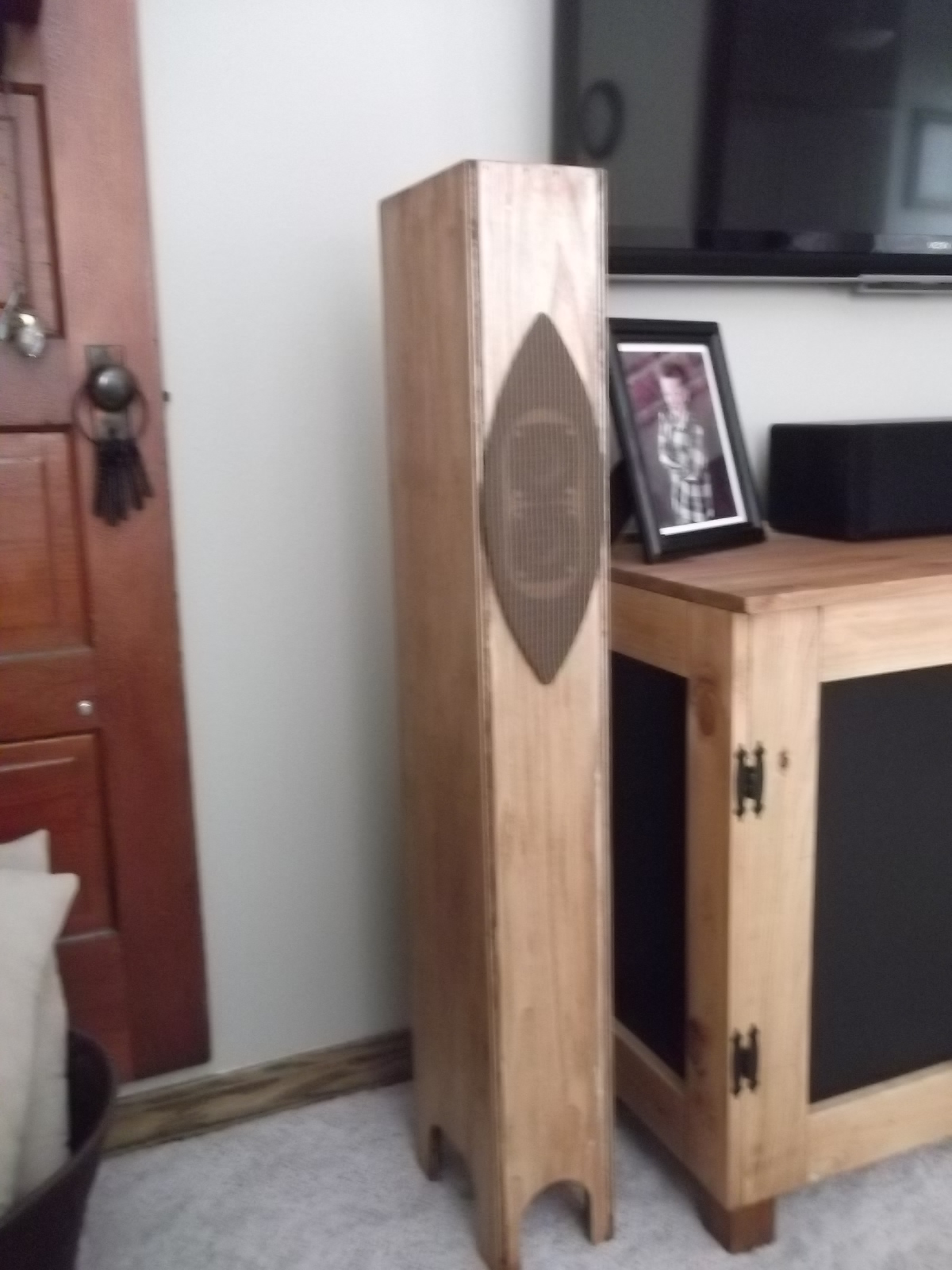
Fifth example is a folded AMLTL with a Vifa as wall or bookshelf speaker:
http://www.diyaudio.com/forums/full-range/231951-accidental-mltl-technique-16.html#post3466655
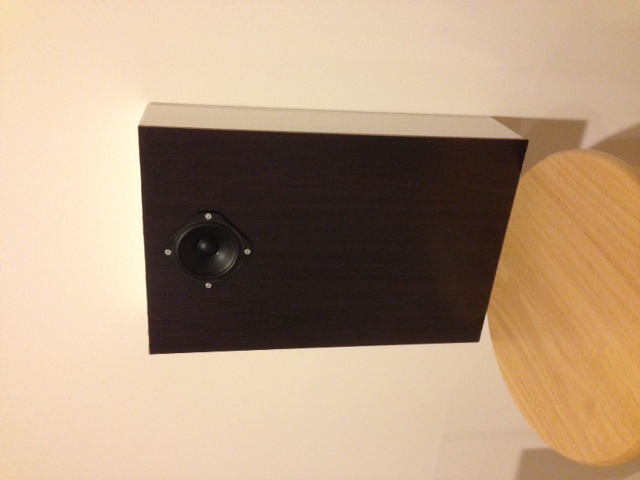
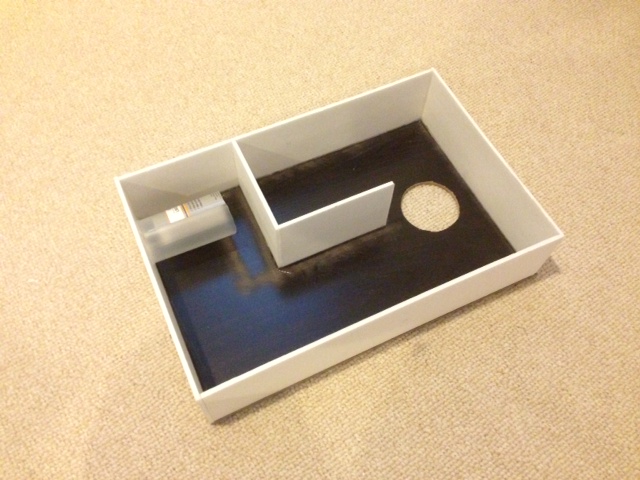
Let me first say that, this is not meant to replace a real simulation, but is rather an observation I have noticed that has worked a few times. I imagine that there are drivers where this will fail. For MLTL's where you want to push the tuning frequency below the natural free space frequency of the driver, choose a driver with a moderately high Qts (> 0.5).
This idea arose out of something I noticed happening on several occasions with a good result. I call it the 'accidental MLTL' technique because it may have been luck or chance but it seems to work a few times now for me (and at least once by others). I originally posted this in Bjohanessens's TABAQ thread but figured it was enough to spin off a new thread. I will repeat that post here...
If you happen to have MJK's MLTL worksheet, give this a try by running a simulation with your driver and running WinISD and calculating the CSA, length, and vent and compare the two. It would be interesting to hear your results.
----
Use WinISD bass reflex software (free) and plug in your driver's T/S params and design a vented bass reflex speaker enclosure using the default optimal case. That will give you the volume of the box and the vent cross sectional area and length.
Now choose a maximum length you are willing to have based on practical size constraints, typically 30 inches to 40 inches long. This will correspond to a quarter wave length that is probably higher than the tuning freq of the bass reflex design that came out of WinISD (circa 60 to 75 Hz).
Calculate the cross sectional area (csa) of the transmission line using volume from WinISD and the length you set. If the csa is bigger than you prefer, you can go off the optimal case by going back to WinISD and adjusting the box volume manually to a smaller value and tweaking the frequency even. You can play with the vent to get it to a diam and length you like. Typically, I do this because the default vent is not very practical. Then use new box volume and vent dimensions to calculate the new csa based in length of the line again.
Now build the enclosure with the csa and length and put a vent with dimensions from WinISD at the distal end. On the closed end, measure 1/3 of distance down and make cutout for driver and mount it there. Put polyfill stuffing from closed end to about half to 2/3 of the way down the line. Adjust this to taste, less stuffing gets more boomy bass. More stuffing gets tighter bass at expense of amplitude. I have found that the position of the driver need not be exactly at 2/3 and indeed can even be at the closed end.
Doing this approach will guarantee that at worst, the speaker will perform as a bass reflex optimized for volume and vent size. But if physics of a MLTL and quarter wave theory kick in, you will end up with a speaker that has deeper bass extension than predicted by WinISD. The speakers that I have built following this recipe have measured very well when I look at what is coming from the bass port - typically, I get the low frequency extended or 'pulled down' by an additional 15 Hz from the plain bass reflex prediction. The speakers also sound great - very balanced when the bass port output integrates with the direct radiation from the driver.
If you want to experiment without investing too much in wood, use foam core to build quick and dirty speaker. Even cardboard can be used as a test speaker for this.
----
Here are the two examples that have worked for me:
http://www.diyaudio.com/forums/full-range/223313-foam-core-board-speaker-enclosures-148.html

http://www.diyaudio.com/forums/full-range/223313-foam-core-board-speaker-enclosures-109.html

A third example not by me might be Cogitech's "nano tower" speaker with the ubiquitous TB W3-881si. Which I think was also designed as a bass reflex with WinISD but due to its slender aspect ratio and length, happens to have some very nice bass deeper than one would expect based on accounts from builders.
http://www.diyaudio.com/forums/full-range/200912-nanotower-tang-band-w3-881si.html

Update : 4th example is a quad driver bipole with W3-881si http://www.diyaudio.com/forums/full-range/234535-tangband-w3-881-mltl-build.html

Fifth example is a folded AMLTL with a Vifa as wall or bookshelf speaker:
http://www.diyaudio.com/forums/full-range/231951-accidental-mltl-technique-16.html#post3466655


Last edited:
On a couple of occasions I've tried a similar approach, more often as a comparison excercise between WinISD and Hornresp, which can do pipes and MLTL to a certain extent. I may have build one or two boxes this way which turned out OK.
I've often seen GM post an old-school rule of thumb where you make Vb = the volume where a sealed enclosure will raise driver Fs by 1.56, make it ~1m tall and tune it to driver Fs. I think this is optimized for high Z amps though. I often end-up with a decent-looking simulation in HR with this starting point.
IG
I've often seen GM post an old-school rule of thumb where you make Vb = the volume where a sealed enclosure will raise driver Fs by 1.56, make it ~1m tall and tune it to driver Fs. I think this is optimized for high Z amps though. I often end-up with a decent-looking simulation in HR with this starting point.
IG
IG,
Can you clarify the GM rule of thumb? Set L=1 m (about 40 in) and adjust the CSA to get the same Vb as predicted by ideal volume for sealed enclosure? Then how do you tune enclosure to driver Fs?
Can you clarify the GM rule of thumb? Set L=1 m (about 40 in) and adjust the CSA to get the same Vb as predicted by ideal volume for sealed enclosure? Then how do you tune enclosure to driver Fs?
WIBAQ Test Case with AMLTL Technique
As a test case to see how close the method comes to a proven design for a TABAQ from an MJK simulation, I will try to generate an Accidental MLTL (AMLTL) for the Betsy K - you can see the design in the WIBAQ thread http://www.diyaudio.com/forums/full-range/226767-wibaq-tabaq-design-betsy-k-2.html.
I will assume a couple of things similar to the WIBAQ: the enclosure height of 45 inches, the baffle width of 11 inches, and the slot vent height of 1-5/8 inches. The vent doesn't really matter as the length will adjust accordingly for different vent CSA's. I just chose the same one to see what the vent length will be.
I put the T/S parameters for the Betsy K into WinISD. The Betsy K is a fantastic value by the way - where else can you find a wide bandwidth 95 dB efficient 8 inch full ranger for $110/pair?
The initial default tuning parameter comes up as 43.8 Hz with a box volume of 126 liters. This fb is not low enough for us to reach into the 30 Hz region but provides a very flat bass reflex response curve assuming a non MLTL box. However, we have the benefit of the quarter wave and the MLTL to help us, so let's push the tuning frequency lower manually by adjusting it to say 35 Hz in order to achieve a response curve with a mass corner that reaches down to the mid 30 Hz. WinISD now says the volume is 128 liters. I now go to the vent tab and set a rectangular vent with 11 in width x 1-5/8 in height. WinISD then returns a vent length of 4 inches an exact match of the vent length from the WIBAQ.
Now let's calculate the box dimensions given the volume of 128 liters, the baffle width of 11 inches (internal dims) and the enclosure height of 45 inches. 128 liters is 4.55 cu ft. With a 0.917 ft wide baffle, the depth (internal dim) is thus 15.8 inches (I will round off to 16 in deep).
So my AMLTL design is:
45 in tall x 11 in wide x 16 in deep
Vent of 11 in wide x 1-5/8 in high x 4.0 in long
By default we place the driver at 1/3 from top, but you can vary this quite a bit and it won't hurt too much. On the WIBAQ it was moved higher up to ear level and it actually improved the performance in the simulation.
Compare to the WIBAQ design, the only thing that is different is the depth which is 16.25 inches! The volume is off by only 1.5% - probably negligible amount. I would imagine that the AMLTL Betsy K design would sound essentially identical to the WIBAQ.
Eerily close isn't it? 😀
OK, this will make it 3 examples where the AMLTL method works!
As a test case to see how close the method comes to a proven design for a TABAQ from an MJK simulation, I will try to generate an Accidental MLTL (AMLTL) for the Betsy K - you can see the design in the WIBAQ thread http://www.diyaudio.com/forums/full-range/226767-wibaq-tabaq-design-betsy-k-2.html.
I will assume a couple of things similar to the WIBAQ: the enclosure height of 45 inches, the baffle width of 11 inches, and the slot vent height of 1-5/8 inches. The vent doesn't really matter as the length will adjust accordingly for different vent CSA's. I just chose the same one to see what the vent length will be.
I put the T/S parameters for the Betsy K into WinISD. The Betsy K is a fantastic value by the way - where else can you find a wide bandwidth 95 dB efficient 8 inch full ranger for $110/pair?
The initial default tuning parameter comes up as 43.8 Hz with a box volume of 126 liters. This fb is not low enough for us to reach into the 30 Hz region but provides a very flat bass reflex response curve assuming a non MLTL box. However, we have the benefit of the quarter wave and the MLTL to help us, so let's push the tuning frequency lower manually by adjusting it to say 35 Hz in order to achieve a response curve with a mass corner that reaches down to the mid 30 Hz. WinISD now says the volume is 128 liters. I now go to the vent tab and set a rectangular vent with 11 in width x 1-5/8 in height. WinISD then returns a vent length of 4 inches an exact match of the vent length from the WIBAQ.
Now let's calculate the box dimensions given the volume of 128 liters, the baffle width of 11 inches (internal dims) and the enclosure height of 45 inches. 128 liters is 4.55 cu ft. With a 0.917 ft wide baffle, the depth (internal dim) is thus 15.8 inches (I will round off to 16 in deep).
So my AMLTL design is:
45 in tall x 11 in wide x 16 in deep
Vent of 11 in wide x 1-5/8 in high x 4.0 in long
By default we place the driver at 1/3 from top, but you can vary this quite a bit and it won't hurt too much. On the WIBAQ it was moved higher up to ear level and it actually improved the performance in the simulation.
Compare to the WIBAQ design, the only thing that is different is the depth which is 16.25 inches! The volume is off by only 1.5% - probably negligible amount. I would imagine that the AMLTL Betsy K design would sound essentially identical to the WIBAQ.
Eerily close isn't it? 😀
OK, this will make it 3 examples where the AMLTL method works!
Last edited:
IG,
Can you clarify the GM rule of thumb? Set L=1 m (about 40 in) and adjust the CSA to get the same Vb as predicted by ideal volume for sealed enclosure? Then how do you tune enclosure to driver Fs?
Plug the driver in WinISD, make a sealed box that raises Fs by 1.56. Make a ~1m tall box of this volume with appropriate CSA, and you tune it to Fs by adjusting the mass-loading port geometry, ideally located somewhere close to the end of the line. I suppose driver should be somewhere close to 1/5 or 1/3 down the line and port in the last third, though I have no RoT for this. Hornresp will only permit a port at the very end of the line, but driver can be made to be anywhere (OD straight-horn).
Hopefully GM will catch this thread and correct or add to what I've written.
IG
Last edited:
Hornresp usually works best for this. If you then plug the data into MJK's worksheets you usually find you get a big extra extension one boundary conditions are taken into account, but it usually gets it pretty spot on.
I agree that Hornresp will predict the MLTL low freq spot on and I use Hornresp for this very purpose - the 10 to 15 Hz rule of thumb seems to work for predicting how much lower the freq will go given the BR prediction in WinISD. Some folks may be a little intimidated by Hornresp at first, and I am just trying to reduce the activation energy needed for people to jump in and try a MLTL with their favorite driver.
XRK,
Cool thread and thanks for the mention of my accident 🙂
I'll be doing some frequency response sweeps later today so will be able to post comparisons between my nanoTowers and two other sets of speakers; my dual EL70 microTowers and my new (not quite tuned, possibly destined for the dump) Pensil 10.2s.
Cool thread and thanks for the mention of my accident 🙂
I'll be doing some frequency response sweeps later today so will be able to post comparisons between my nanoTowers and two other sets of speakers; my dual EL70 microTowers and my new (not quite tuned, possibly destined for the dump) Pensil 10.2s.
XRK,
Cool thread and thanks for the mention of my accident 🙂
I'll be doing some frequency response sweeps later today so will be able to post comparisons between my nanoTowers and two other sets of speakers; my dual EL70 microTowers and my new (not quite tuned, possibly destined for the dump) Pensil 10.2s.
You're welcome. 🙂 It was actually your "accident" and fact that I am able to make stuff out of foam core in a matter of hours that led me to be so cavalier and to purposely try to get a MLTL effect without a sim on MJK. I would do sims on Hornresp and see the low bass peak but there is no provision for stuffing so I never knew that the bass output would actually look like a flat-top hump like a "loaf of bread".
Sorry to hear about the new Pensil's - what happened?
Last edited:
Sorry to hear about the new Pensil's - what happened?
I was getting along great with them, then last night I played "With or Without You by U2. The bass-line in that song is one that is ingrained in my head, and I have heard it played correctly so many times I would be embarrassed to say.
Within the first four notes on the Pensils, I knew something was very, very wrong. I eventually realized the cabinets (or their interaction with my room) have a huge, deep null somewhere down low. 2 notes out of the 4-note bass-line were down 15dB or more from the other notes. It was almost like Adam just wasn't playing the notes.
I messed with the EQ and had to get very aggressive with it and even then the bass-line was a mess.
Tuxedo will find it hard to believe, but my accidental nanoTowers can do bass more consistently than my Pensils.
Last edited:
If it is a room effect, does it change depending on where you sit in the room to listen to it? Doing a measurement will tell a lot. That's interesting that a bass line from a favorite song is what tipped you off. If it is everywhere in the room then the measurement will reveal a big dip in the bass. One other thing, have you checked for air leaks around your driver gaskets or lack of wood glue to seal your cabinets? A small hairline air gap due to bad glue seal can mess with the low bass notes. Is it the low low 41 Hz note?
I once made an accidental TL. At least I think I did. Built a really tall MTM and put the port near the bottom. Just did. Had a ton of bass. But wasn't very good. Considering I screwed up, it's not a surprise. I've learned since then. I usually just stick to sealed boxes now. If I wasn't a subwoofer user I'd want to learn more about TLs.
You will find these programs useful if you are interested in experimenting with MLTL alignments using just free software.
Transmission Line Alignment Tables Spreadsheet by Keith Web on
Transmission Line Theory
Hornresp Plots MLTL SPL response without stuffing effects.
Akabak .. does it all pretty well. Hornresp design data can be exported to Akabak.
ROUGH:
1) use Keith Webb's Excel spread to enter your speakers T/S parameters and use a SL/SO taper=1 to get the Tline cross section area. This area can be entered into Hornresp for a good quality MLTL simulation
2) use Keith Webb's Excel spread to enter your speakers T/S parameters and use a SL/SO taper= 0.05 to 0.1 to mimic the bottom MLTL port area to get the MLTL total height. This height can be entered into Hornresp for a good quality MLTL simulation. These good estimated help you tune a Hornresp design.
3) After studying MLK's MLTL website information you can decide on where to position the speaker and port. The diameter of the speaker also affects the offset distance. You do not want to put a 16" Altec 604 very close to the top. Locating the speaker center in the TL length 0.20x to 0.33x from the top is a good start. A 0.33x spacing removes many harmonics.
4) You can export the Hornresp design data into Akabak and fine tune the port position and the stuffing.
5) DO NOT FORGET ROOM EFFECTs. Many MLTL's depend upon rear wall or corner effects to get the best in-room performance.
Download the free
Baffle Edge Diffraction Simulator Ver 1.2 by Jeff Bagby
"Diffraction & Boundary Simulator 1.20"
6) There are genius designers that blend quarter wave TL tuning with clever BR stuffing and port design.
Transmission Line Alignment Tables Spreadsheet by Keith Web on
Transmission Line Theory
Hornresp Plots MLTL SPL response without stuffing effects.
Akabak .. does it all pretty well. Hornresp design data can be exported to Akabak.
ROUGH:
1) use Keith Webb's Excel spread to enter your speakers T/S parameters and use a SL/SO taper=1 to get the Tline cross section area. This area can be entered into Hornresp for a good quality MLTL simulation
2) use Keith Webb's Excel spread to enter your speakers T/S parameters and use a SL/SO taper= 0.05 to 0.1 to mimic the bottom MLTL port area to get the MLTL total height. This height can be entered into Hornresp for a good quality MLTL simulation. These good estimated help you tune a Hornresp design.
3) After studying MLK's MLTL website information you can decide on where to position the speaker and port. The diameter of the speaker also affects the offset distance. You do not want to put a 16" Altec 604 very close to the top. Locating the speaker center in the TL length 0.20x to 0.33x from the top is a good start. A 0.33x spacing removes many harmonics.
4) You can export the Hornresp design data into Akabak and fine tune the port position and the stuffing.
5) DO NOT FORGET ROOM EFFECTs. Many MLTL's depend upon rear wall or corner effects to get the best in-room performance.
Download the free
Baffle Edge Diffraction Simulator Ver 1.2 by Jeff Bagby
"Diffraction & Boundary Simulator 1.20"
6) There are genius designers that blend quarter wave TL tuning with clever BR stuffing and port design.
Attachments
Line Source,
Yes, I am aware of these resources and I also use Akabak. The point of my thread is that it doesn't matter, all you need to do is design for a bass reflex alignment tuned lower than you normally would (no more than 75% of fs) and build the bass reflex box in a long aspect ratio between 30 to 45 inches depending on fs. Set your length and baffle width and the volume gives the depth and the bass reflex program also gives the vent dimensions. Magically, maybe luck, it ends up close to what MJK optimization might produce.
Yes, I am aware of these resources and I also use Akabak. The point of my thread is that it doesn't matter, all you need to do is design for a bass reflex alignment tuned lower than you normally would (no more than 75% of fs) and build the bass reflex box in a long aspect ratio between 30 to 45 inches depending on fs. Set your length and baffle width and the volume gives the depth and the bass reflex program also gives the vent dimensions. Magically, maybe luck, it ends up close to what MJK optimization might produce.
I was getting along great with them, then last night I played "With or Without You by U2. The bass-line in that song is one that is ingrained in my head, and I have heard it played correctly so many times I would be embarrassed to say.
Within the first four notes on the Pensils, I knew something was very, very wrong. I eventually realized the cabinets (or their interaction with my room) have a huge, deep null somewhere down low. 2 notes out of the 4-note bass-line were down 15dB or more from the other notes. It was almost like Adam just wasn't playing the notes.
I messed with the EQ and had to get very aggressive with it and even then the bass-line was a mess.
Tuxedo will find it hard to believe, but my accidental nanoTowers can do bass more consistently than my Pensils.
I have always enjoyed 'mysterious ways' by U2 as a bass test song. With that song my fathers Bose 301s sound pretty nasty. The tuning of the cabinet seems to not have a dead spot so much but a live spot where that note is deafeningly loud compared to everything else. It's probably just an inherent problem with resonant systems- with my WiBAQ you have go turn up the volume pretty high to 'activate' the cabinet and get the air moving to get some real bass.
If it is a room effect, does it change depending on where you sit in the room to listen to it? Doing a measurement will tell a lot. That's interesting that a bass line from a favorite song is what tipped you off. If it is everywhere in the room then the measurement will reveal a big dip in the bass. One other thing, have you checked for air leaks around your driver gaskets or lack of wood glue to seal your cabinets? A small hairline air gap due to bad glue seal can mess with the low bass notes. Is it the low low 41 Hz note?
It is the lowest of the 4 notes in that bass line, and much of the second-lowest note as well. On the other hand, the two higher notes are very BOOMY.
Listen to the song again if you have it and imagine that the first 8 notes are solid and BOOMY, then the second 8 notes nearly disappear, then back to BOOMY, then disappear to a lesser extent.
It is annoying as sh!t, and my other two pairs of speakers don't do it. Each note has the same volume.
Got the issue mostly solved.
http://www.diyaudio.com/forums/full-range/231879-alpair-10-2-castle-4.html#post3409963
http://www.diyaudio.com/forums/full-range/231879-alpair-10-2-castle-4.html#post3409963
Glad you fixed it. I did not realize you stuffed all the way either. I learned from TABAQ that bottom third is empty and that has just stuck with me. Sometimes I remove up to 1/2 along length for extra bass.
You guys sound like you expected a MLTL to have significantly different response than a vented box of the same volume. The MLTL will have extended low end, but not by 10 or 20Hz as you all seem to have expected. It will be be a few hz.
Using a vented box model and having it be close to an MLTL shouldn't be a revelation.
Having "lots of bass" out of a tall ported box shouldn't be a surprise if your normal build is a sealed box.
Using a vented box model and having it be close to an MLTL shouldn't be a revelation.
Having "lots of bass" out of a tall ported box shouldn't be a surprise if your normal build is a sealed box.
- Home
- Loudspeakers
- Full Range
- Accidental MLTL Technique

